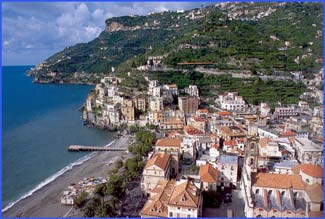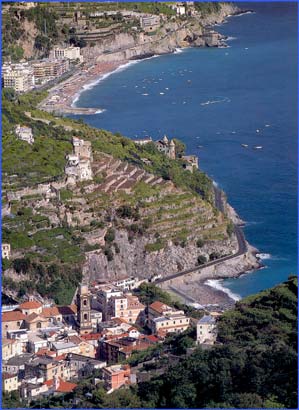|
 Minori
derives its name from the torrent Reginna Minor (or Reginuolo) that crosses it.
It has been inhabited since Roman times, as some remains of the splendid Villa
Romana testify. In the Middle Ages it had a more than adequate economic
development, in fact, Minori had been a Diocese since 987, due to Pope Giovanni
XV’s will and shared the histoiy and fate of the near Amalfi, with which it
was often in competition. lt is a small but very nice town with a beautiful
promenade, enriched by a splendid Ilth-century fountain (Lions'Fountain) and a
net of picturesque and lively lanes. Minori
derives its name from the torrent Reginna Minor (or Reginuolo) that crosses it.
It has been inhabited since Roman times, as some remains of the splendid Villa
Romana testify. In the Middle Ages it had a more than adequate economic
development, in fact, Minori had been a Diocese since 987, due to Pope Giovanni
XV’s will and shared the histoiy and fate of the near Amalfi, with which it
was often in competition. lt is a small but very nice town with a beautiful
promenade, enriched by a splendid Ilth-century fountain (Lions'Fountain) and a
net of picturesque and lively lanes.
Minori
has often been devastated by natural catastrophes and plagues: a tempest in 1597
was particularly terrible, it destroyed the walls and the main square. The
Cathedral deserves a visit: it
 preserves
S. Trofimena's relics , a saint venerated all along the Coast. A
17th-century marble pulpit is very remarkable. A wooden Baroque altar is
interesting too, it is in the Church of S. Lucia at Benedictine Convent. preserves
S. Trofimena's relics , a saint venerated all along the Coast. A
17th-century marble pulpit is very remarkable. A wooden Baroque altar is
interesting too, it is in the Church of S. Lucia at Benedictine Convent.
However,
above all , Minori offers the possibilità of visiting the remains of a Roman
Villa of the Augustean Age (i st century), built on a 2500-square-metre arca.
Excavations began in 1932 and were continued after the flood of 1954 buried it
under a blanket of mud. The building had two storeys originally, but the
top floor has been lost.
The
ground floor is still intact and is surrounded by three archways and a nymphaeum
and is decorated by frescoes and mosaies.
In
the inside a swimming-pool of Roman times was discovered.
The
Roman Villa is of a great archacological interest: it is the only evidence of
this type on the Coast. lt permits historians to verify their theorics about the
importance of the Villa (and in particular of Minori) during Roman dominion.
On
the other hand, even its toponym, that is its country name, is of Latin origin,
like that of the near Maiori.
Besides,
perhaps it will be necessary to explain that the augmentative (maior that is
bigger) and the diminutive (minor, that is smaller) do not refer to the
importance or size of the respective towns, but to the torrents' flow crossing
their centres and having the same name, Reginna Maior the former and Reginna
Minor the latter. These torrents are both terrible when they fall headlong
into the sca during the winter. As a matter of fact both towns have often
been devastated by terrible floods. Fortunately, today, this danger is
only a memory of the past thanks to the progress of civil engineering.
|
